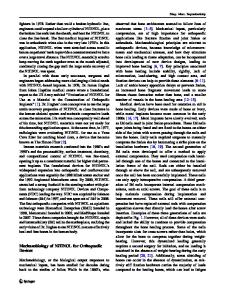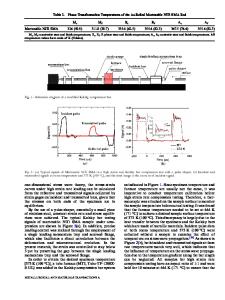Strain dependence of pseudoelastic hysteresis of NiTi
- PDF / 210,757 Bytes
- 8 Pages / 612 x 792 pts (letter) Page_size
- 90 Downloads / 279 Views
I. INTRODUCTION
THE stress hysteresis of pseudoelasticity associated with thermoelastic martensitic transformations in shape-memory alloys has been reported in the literature to be either dependent or independent of the transformation strain under various conditions. In the former case, the magnitude of the stress hysteresis is found to increase with the strain amplitude of a pseudoelastic loop.[1,2,3] In the latter case, the hysteresis is observed to be independent of the strain of the pseudoelastic loop within the strain limit of a stress-induced martensitic transformation.[4,5] The transformation-strain independence of pseudoelastic hysteresis is often observed in tensile testing using specimens of large length-to-diameter aspect ratios for binary NiTi alloys.[4,5] In shear deformation of similar alloys, however, a transformation strain–dependent pseudoelastic hysteresis has been observed.[2] This uncertainty has caused some inconsistency in the effort of modeling the thermomechanical behavior of shape-memory alloys and the understanding of the thermodynamics of thermoelastic martensitic transformations. It has been well established that the process of a thermoelastic martensitic transformation, either thermally induced or stress induced, is accompanied by an internal elastic energy and an irreversible energy.[6,7] The irreversible energy is believed to be responsible for the hysteretic behavior of the transformation. The dissipation of the irreversible energy during the course of a thermoelastic martensitic transformation is due to the need to overcome the resistance from an imperfect matrix to the diffusionless, displacive movement of a transformation-phase boundary. It is generally regarded that this resistance, originating from structural defects, is determined by the metallurgical conditions of the matrix YINONG LIU, Senior Lecturer, I. HOUVER, Research Engineer, and H. XIANG, Postgraduate Student, are with the Department of Mechanical and Materials Engineering, University of Western Australia, Nedlands, WA 6907, Australia. L. BATAILLARD, Postdoctoral Fellow, formerly with the Department of Mechanical and Materials Engineering, University of Western Australia, is with Sokymat S.A., Granges, Switzerland. S. MIYAZAKI, Professor, is with the Institute of Materials Science, University of Tsukuba, Ibaraki 305-8573, Japan. Manuscript submitted February 9, 1998. METALLURGICAL AND MATERIALS TRANSACTIONS A
and, thus, the irreversible energy is a material constant. Consequently, the transformation hysteresis, either the temperature hysteresis of a thermal transformation cycle or the stress hysteresis of a mechanical transformation cycle, is expected to be a constant, ignoring possible modifications to the microstructure during one individual transformation cycle. Based on this understanding, irreversible energy has been estimated from experimental measurements of transformation hysteresis, and the estimated values have been used in thermodynamic analysis.[8,9,10] Therefore, it is of direct interest and primary impo
Data Loading...











